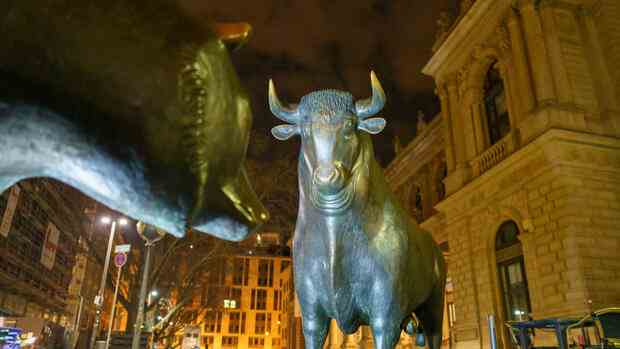Signs of euphoric sentiment among investors.
(Photo: dpa)
Dusseldorf The stock market is celebrating, there are even first signs of a euphoric mood. This shows the evaluation of the Handelsblatt survey Dax-Sentiment.
This mood shouldn’t come as a surprise, because the Dax had its best start to the year of all time with an increase of 8.4 percent in just ten trading days. In particular, the titles that sold out the most in the past year were among the biggest winners in the first few days of the new year.
For attentive readers of the sentiment evaluation, the interpretation seems simple in such a case: Because of this euphoric mood, there is now a counter-movement according to sentiment theory.
But it’s not that easy, says sentiment expert Stephan Heibel, who evaluates the weekly Handelsblatt survey. “A good mood when prices are rising alone is not an alarm signal, not even according to sentiment theory,” he explains. “The predominantly pessimistic future expectations of investors are supporting the ongoing rally well.”
Top jobs of the day
Find the best jobs now and
be notified by email.
If the majority of investors expect prices to fall, they will position themselves accordingly and have already sold some of their shares. “According to Boerse Stuttgart’s Euwax sentiment, private investors have bought many put warrants in order to be prepared for a continuation of the bear market,” he explains.
This also explains the market reaction to the weak quarterly figures from US banks last Friday. Prices fell a little for a short time, but there were hardly any other sellers because most investors expect prices to fall.
Current survey data
Investor sentiment has jumped to 4.5 points from just 2.3 a week ago. There is a celebratory mood among investors, euphoria is spreading. The complacency indicator, which showed investor uncertainty throughout 2022, also jumped to plus 2.1, the highest value in thirteen months.
The future expectation, on the other hand, has dropped to minus 1.1. Investors therefore mainly fear falling prices for the coming months. While the survey participants are pleased with the price gains, they consider the development to be a flash in the pan, perhaps even a mistake that could soon be corrected again.
The willingness to invest is correspondingly low at plus 0.9. This is also an extreme value: It is the lowest willingness to invest in exactly one year.
The Euwax sentiment of the Stuttgart Stock Exchange, where private investors trade, has slipped to minus seven. If the value of the index is positive, the majority is betting on a rising market. A negative value, on the other hand, means that investors are more likely to assume that prices will fall. Private investors are currently hedging their book profits by purchasing put leverage products.
However, institutional investors who hedge themselves via the Frankfurt futures exchange Eurex are still optimistic. The put/call ratio of 1.8 shows only average hedging activity by institutional investors.
In the USA, on the other hand, the propensity to hedge has increased, and the put/call ratio on the Chicago futures exchange CBOE is at its highest level in recent months. The fear of a recession in the US is great. US fund managers have slightly increased their investment ratio from a low level to 45 percent.
US private investors still can’t shake off their pessimism: The bull-bear difference is minus 16. The proportion of pessimists, called bears, is 40 percent, that of bulls 24 percent.
The “fear and greed indicator” of the US markets, calculated using technical market data, shows “moderate greed” with a value of 61 percent, but ultimately this value can still be described as neutral.
Other short-term technical indicators are showing an overbought market, suggesting consolidation is imminent. The heavily fluctuating Short Range Oscillator of the US stock exchange barometer S&P 500 has already jumped to plus nine. From values of plus four one speaks of an overbought market. Values above nine were last reached in the summer of 2020, when the corona crash was caught up in record time.
Special mood on the gold market
There is still a special sentiment situation for gold. The mood reads “Champagne Mood”. No wonder, since the price of gold has climbed from 1,650 to 1,900 dollars per troy ounce since September. An increase of 15 percent in three months is already a significant change. No wonder the mood is exuberantly good.
At the same time, however, expectations for the future have fallen to a low point. Here too, this means that hardly anyone expects the price of gold to continue to rise. “Profit-taking could soon put a temporary end to the rally,” explains Heibel.
This should not result in significantly falling prices, the pessimism is too great for that. Beyond a few profit-taking, no selling pressure should be exerted on gold prices even if a downside surprise hits the market. “So a breather for the gold rally would be the most likely scenario for the next one to two weeks,” says the sentiment expert.
There are two assumptions behind surveys such as the Dax sentiment with more than 7,800 participants: if many investors are optimistic, they have already invested. Then only a few are left who could still buy and thus drive prices up. Conversely, if investors are pessimistic, the majority of them have not invested. Then only a few can sell and thus depress the courses.
Do you want to take part in the survey? Then let yourself be informed automatically about the start of the sentiment survey and register for the Dax sentiment newsletter. The survey starts every Friday morning and ends on Sunday afternoon.
More: Investors make these ten mistakes from the point of view of stock market psychologists.

